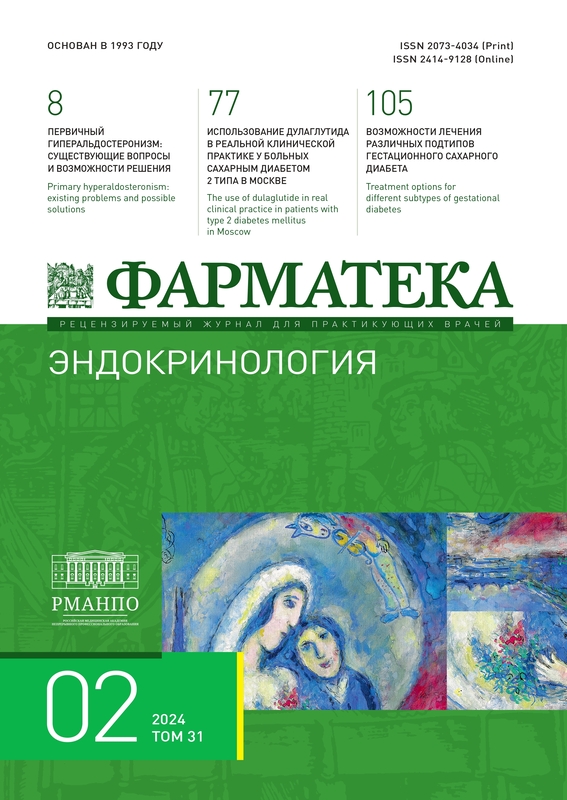Safety of continuous glycemic monitoring system in patients after total duodenopancreatectomy in the early postoperative period. Single-center retrospective cohort study
- Authors: Farmanov A.G.1,2, Bublik E.V.1, Vinogradskaya O.I.1, Udovichenko O.V.1, Zilov A.V.1,2, Ryzhkova E.G.1,2, Egorov V.I.1, Fadeev V.V.2, Deunezheva S.M.1, Zhivov A.V.1, Tobianskaya I.E.1
-
Affiliations:
- Ilyinskaya Hospital
- I.M. Sechenov First Moscow State Medical University (Sechenov University)
- Issue: Vol 31, No 2 (2024)
- Pages: 142-148
- Section: Original articles
- Published: 23.05.2024
- URL: https://journals.eco-vector.com/2073-4034/article/view/632465
- DOI: https://doi.org/10.18565/pharmateca.2024.2.142-148
- ID: 632465
Cite item
Abstract
Background. Among the various types of pancreatogenic diabetes mellitus, the greatest difficulties in glycemic control arise in patients after total duodenopancreatectomy (TDPE). This is associated to the presence of an absolute deficiency of insulin secreted by β-cells and a lack of glucagon secreted by α-cells of the pancreas.
Objective. Evaluation of the safety of using the Guardian Connect continuous glucose monitoring (CGM) system in the early postoperative period in patients after TDPE.
Methods. A retrospective assessment of glucose values recorded in the electronic medical record of 28 patients after TDPE who were followed-up in the clinic from 2020 to 2023 was carried out. In group 1, 13 patients were monitored for glycemic control using the Guardian Connect CGM system (in parallel with the use of a glucometer). In group 2, 15 patients underwent glycemic control only using a glucometer.
Results. Intravenous insulin therapy: glucose levels in group 1 were statistically significantly more likely to be in the target range of 5.6–10.0 mmol/L (p = 0.005) and in the range from 4.3 to 11.6 mmol/L (p=0.001). When assessing the number of hypoglycemia episodes below 3.9 mmol/l, the frequency of this side effect was statistically significantly lower in group 1 (p<0.001). The results of the analysis of episodes of severe hypoglycemia showed a lower frequency in group 1 (p>0.05), but the results were not statistically significant. Subcutaneous insulin therapy: glucose levels in group 1 were statistically significantly more likely to be in the target range of 5.6–10.0 mmol/l (p=0.017) and in the range from 4.3 to 11.6 mmol/l (p = 0.017) compared to group 2. When assessing the number of episodes of hypoglycemia below 3.9 mmol/l, no statistically significant differences were found between groups (p<0.112). There were no episodes of severe hypoglycemia in both groups.
Conclusion. The results of our study demonstrate the safety of use of the CGM system in patients in the early postoperative period after TDPE.
Full Text
About the authors
A. G. Farmanov
Ilyinskaya Hospital; I.M. Sechenov First Moscow State Medical University (Sechenov University)
Author for correspondence.
Email: a.farmanov@ihospital.ru
ORCID iD: 0000-0002-5700-7663
Endocrinologist, Graduate Student of the Department of Endocrinology, Institute of Clinical Medicine No. 1 n.a. N.V. Sklifosovsky
Russian Federation, Krasnogorsk, Moscow region; MoscowE. V. Bublik
Ilyinskaya Hospital
Email: a.farmanov@ihospital.ru
ORCID iD: 0000-0003-2998-0893
Russian Federation, Krasnogorsk, Moscow region
O. I. Vinogradskaya
Ilyinskaya Hospital
Email: a.farmanov@ihospital.ru
ORCID iD: 0000-0002-0271-9727
Russian Federation, Krasnogorsk, Moscow region
O. V. Udovichenko
Ilyinskaya Hospital
Email: a.farmanov@ihospital.ru
ORCID iD: 0000-0003-2991-7130
Russian Federation, Krasnogorsk, Moscow region
A. V. Zilov
Ilyinskaya Hospital; I.M. Sechenov First Moscow State Medical University (Sechenov University)
Email: a.farmanov@ihospital.ru
ORCID iD: 0000-0003-3494-8011
Russian Federation, Krasnogorsk, Moscow region; Moscow
E. G. Ryzhkova
Ilyinskaya Hospital; I.M. Sechenov First Moscow State Medical University (Sechenov University)
Email: a.farmanov@ihospital.ru
ORCID iD: 0000-0003-0069-1692
Russian Federation, Krasnogorsk, Moscow region; Moscow
V. I. Egorov
Ilyinskaya Hospital
Email: a.farmanov@ihospital.ru
ORCID iD: 0000-0002-8805-7604
Russian Federation, Krasnogorsk, Moscow region
V. V. Fadeev
I.M. Sechenov First Moscow State Medical University (Sechenov University)
Email: a.farmanov@ihospital.ru
ORCID iD: 0000-0002-3026-6315
Russian Federation, Moscow
S. M. Deunezheva
Ilyinskaya Hospital
Email: a.farmanov@ihospital.ru
ORCID iD: 0000-0002-3104-3412
Russian Federation, Krasnogorsk, Moscow region
A. V. Zhivov
Ilyinskaya Hospital
Email: a.farmanov@ihospital.ru
ORCID iD: 0009-0009-6916-6328
Russian Federation, Krasnogorsk, Moscow region
I. E. Tobianskaya
Ilyinskaya Hospital
Email: a.farmanov@ihospital.ru
ORCID iD: 0009-0000-1381-7210
Russian Federation, Krasnogorsk, Moscow region
References
- Zhao T., Fu Y., Zhang T., et al. Diabetes management in patients undergoing total pancreatectomy: A single center cohort study. Front Endocrinol. 2023;14:1097139. doi: 10.3389/fendo.2023.1097139.
- Тарасова Ж.С., Бордин Д.С., Килейников Д.В., Кучерявый Ю.А. Панкреатогенный сахарный диабет: взгляд эндокринолога и гастроэнтеролога. Эффективная фармакотерапия. 2020;16(15):92–100. [Tarasova Zh.S., Bordin D.S., Kileinikov D.V., Kucheryavyi Yu.A. Pancreatogenic diabetes mellitus: the view of an endocrinologist and gastroenterologist. Effektivnaya farmakoterapiya. 2020;16(15):92–100. (In Russ.)]. doi: 10.33978/2307-3586-2020-16-15-92-100.
- Yan L., et al. Insulin regulates multiple signaling pathways leading to monocyte/macrophage chemotaxis into the wound tissue. Biol Open. 2018;7(1):bio026187. doi: 10.1242/bio.026187.
- Jabłonska B., Mrowiec S. Pancreatectomy and Pancreatic Surgery. Life (Basel). 2023;13(6):1400. doi: 10.3390/life13061400.
- Scholten L., Stoop T.F., Del Chiaro M., et al. Systematic review of functional outcome and quality of life after total pancreatectomy. Br J Surg. 2019;106(13):1735–46. doi: 10.1002/bjs.11296.
- Khatkov I.E., et al. Russian Consensus on Exo- and Endocrine Pancreatic Insufficiency After Surgical Treatment. Turk J Gastroenterol. 2021;32(3):225–39. doi: 10.5152/tjg.2021.20445.
- Polavarapu P., et al. Glycemic Management of Hospitalized Patients Receiving Nutrition Support. Diab Spectr. 2022;35(4):427–39. doi: 10.2337/dsi22-0010.
- Spanakis E.K., Urrutia A., Galindo R.J., et al. Continuous Glucose Monitoring-Guided Insulin Administration in Hospitalized Patients with Diabetes: A Randomized Clinical Trial Diab Care. 2022;45(10):2369–75. doi: 10.2337/ dc22-0716.
- Алгоритмы специализированной медицинской помощи больным сахарным диабетом. Под ред. И.И. Дедова, М.В. Шестаковой, А.Ю. Майорова. 11-й выпуск. М., 2023. [Algorithms for specialized medical care for patients with diabetes. Ed. by I.I. Dedov, M.V. Shestakova, A.Yu. Mayorov. 11th issue. Moscow, 2023. (In Russ.)]. Doi: 10.14341/ DM13042.
- Buschur E.O., Faulds E., Dungan K. CGM in the Hospital: Is It Ready for Prime Time? Curr Diab Rep. 2022;22(9):451–60. doi: 10.1007/s11892-022-01484-x.
- Finn E., Schlichting L., Grau L., et al. Real-world Accuracy of CGM in Inpatient Critical and Noncritical Care Settings at a Safety-Net Hospital. Diab Care. 2023;46(10):1825–30. doi: 10.2337/dc23-0089.
Supplementary files










